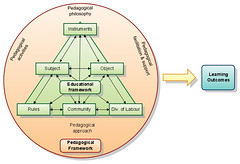 Image by hazelowendmc via Flickr
Image by hazelowendmc via FlickrThey used the Simpson and Anderson (2009, p. 99) definition of blended learning. The study itself was based around an ambitious project that sought to redesign the 4 year BEd programme and to use a single common online learning environment that catered from Palmerston North, Hawkes Bay, and other campus students in an area where they accessed all of their papers, communicated with each other and with academic staff etc.
Data was collected using a questionnaire, followed by an interview for students, and a similar approach for teachers. The aim was to drill down past the quantitative data that had been collected.
Some interested things that arose from the data were questions around what blended actually is, and what we collectively believe to be blended learning, and who the 'we' is. An example of a staff answer" I think there are shared understandings developing in pockets but I think within courses people develop an modify and evolve shared understandings". Definitions of blended learning from staff was "...different philosophies applied by each of the eLearning facilitators"; and "...when people come from different subjects, discipline areas the task is much more difficult because it demands understand of each other's disciplinary approached and the constraints of time are very tight..."
Student views included "the use of [online] enrollment was as a secondary where you could do some extra homework there, if you didn't touch it a all it didn't make much difference to how you went through the class until the second semester" where a blended approach was expected. There were emerging expectations, and the notion of being confronted with alternative expectations, especially where there was a conflict between what was considered face-to-face and extramural, and whether one should 'look' like the other. In part this demonstrates a limited understanding amongst students around what blended learning is, but, surely, it also points up the necessity for programmes to be up front around what is going to happen, how students are going to interact, and not make assumptions around understanding of academic vocabulary?
Mary Simpson considered aspects such as consistency of the vision, which would in turn build a shared understanding of what blended learning comprises. The shared vision included team-based, collegial writing which would be a huge challenge in the university environment. The findings showed that faculty were willing to face the task, but that they found it exhausting, gruelling, and logistically frustrating, while also be enlightening, enriching, and enhanced practice in unexpected ways.
Peter Rawlins gave an overview of how he worked with the data from the study. In every paper there was an expectation that there will be some online aspect. Three-quarters of the students said that they went online more than once a day, and these students were equally spread between internal and extramural students. There was a significant number of students agreed that the online learning helped them succeed, although the distance students were more convinced. In addition, there was strong support that the material and the discussions were useful, but there was approximately 29% who disagreed that this was the case. The students value the face-to-face time, but they do also see the value of the online environment. It is a complex, interconnected picture rather than a simple case of face-to-face or online is 'better', and the students are very aware of this, especially when asked if the environment(s) enriched their learning.
It appears that there is a still a lot to learn around blended learning and offering blended learning programmes. Perhaps we need to engage students a lot more in the development of programmes and programme design from the outset rather than designing courses 'for' them, erring toward a 'one size fits all'? Possibly the group work and collaboration that was trialled within this study could also include either current students or graduates from the programme? If students were brought on board to provide a student voice, to advise and create within a programme at a meta level, in a meaningful way, perhaps retention, success, and a whole raft of affective factors would be enhanced.
![Reblog this post [with Zemanta]](http://img.zemanta.com/reblog_a.png?x-id=84105fec-666f-4e6c-a768-e330a3aef7e0)





No comments:
Post a Comment